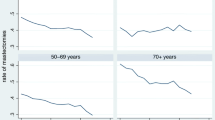Abstract
Background: Breast-conserving surgery (BCS) has been recommended for most early-stage primary breast cancers, but predictors may vary by time and geographic area.
Methods: Among 5,266 early-stage female breast cancers (diagnosed in 1990–1992) in the population-based Connecticut Tumor Registry, the poverty rate of census tract of residence (an ecologic indicator of socioeconomic status), age at diagnosis, race, marital status, extent of disease, year of diagnosis, and town of residence were analyzed in relation to BCS use.
Results: The poverty rate of census tract was not a statistically significant variable in logistic regression analyses of BCS use; however, age, year of diagnosis, and stage at diagnosis were predictors. Residence in a town with a hospital having radiotherapy facilities or near a university hospital were not predictors of BCS use. High BCS rates (69–94% vs. 49% statewide) were found for residents of a cluster of seven contiguous towns associated with a single (nonuniversity) hospital.
Conclusions: BCS was not associated with poverty level of area of residence but continued to be lower for larger or node-positive cancers. Attitudes and practices of local physicians were hypothesized as being important in explaining variation in BCS use by town of residence.
Similar content being viewed by others
References
NIH Consensus Conference. Treatment of early-stage breast cancer.JAMA 1991;265:391–5.
Fisher B. A biological perspective of breast cancer: contributions of the National Surgical Adjuvant Breast and Bowel Project clinical trials.CA 1991;41:97–111.
Abrams JS, Phillips PH, Friedman MA. Meeting highlights: a reappraisal of research results for the local treatment of early stage breast cancer.J Natl Cancer Inst 1995;87:1837–45.
Fisher B, Anderson S, Redmond CK, et al. Reanalysis of results after 12 years of follow-up in a randomized clinical trial comparing total mastectomy with lumpectomy with or without irradiation in the treatment of breast cancer.N Engl J Med 1995;333:1456–61.
Foster RS Jr, Farwell ME, Costanza MC. Breast-conserving surgery for breast cancer: patterns of care in a geographic region and estimation of potential applicability.Ann Surg Oncol 1995;2:275–80.
Nattinger AB, Gottlieb MS, Veum J, Yahnke D, Goodwin JS. Geographic variation in the use of breast-conserving treatment for breast cancer.N Engl J Med 1992;326:1102–7.
Osteen RT, Steele GD Jr, Menck HJ, Winchester DP. Regional differences in surgical management of breast cancer.CA 1992;42:39–43.
Samet JM, Hunt WC, Farrow DC. Determinants of receiving breast-conserving surgery: the Surveillance, Epidemiology, and End Results Program, 1983–1986.Cancer 1994;73:2344–51.
Lazovich D, White E, Thomas DB, et al. Underutilization of breast-conserving surgery and radiation therapy among women with stage I or II breast cancer.JAMA 1991;266:3433–8.
Shambaugh EM, Gloecker Ries L, Young JL, et al. SEER extent of disease—1988: codes and coding instructions. Bethesda, MD: National Cancer Institute, Demographic Analysis Section, Surveillance and Operations Research Branch, 1988.
Shambaugh E. Stat bite: accuracy of SEER data.J Natl Cancer Inst 1991;83:1369.
Pearce NE, Cryer PC. Analysis of the components of a linear trend in proportions.Am J Epidemiol 1986;124:127–33.
Piantidosi S, Byar DP, Gail MH. Screening geographic areas for unusual survival experience or stage at diagnosis with application to breast and colon cancer.J Natl Cancer Inst 1985;75:269–75.
Krieger N. Overcoming the absence of socioeconomic data in medical records: validation and application of a census-based methodology.Am J Public Health 1992;82:703–10.
Randal J. Occupation as carcinogen: federal researcher suggests change in cancer registries.J Natl Cancer Inst 1994;86:1748–50.
Zippin C, Lum D, Hankey BF. Completeness of hospital cancer case reporting from the SEER Program of the NCI.Cancer 1995;76:2343–50.
Munoz F, Shamash F, Friedman M, Teicher I, Wise L. Lumpectomy vs. mastectomy: the costs of breast preservation for cancer.Arch Surg 1986;121:1297–301.
Parker RG. Varying charges for comparably effective cancer treatments.Am J Clin Oncol 1992;15:281–7.
Satariano ER, Swanson GM, Moll PP. Nonclinical factors associated with surgery received for treatment of early stage breast cancer.Am J Public Health 1992;82:195–8.
Polednak AP, Flannery JT. Trends in breast cancer treatment in Connecticut.Conn Med 1993;57:59–64.
Coleman A, Baker A. Stat bite: trends in breast cancer surgery.J Natl Cancer Inst 1991;83:1607.
Farrow DC, Hunt WC, Samet JM. Geographic variation in the treatment of localized breast cancer.N Engl J Med 1992;326:1097–101.
Sastre-Garau X, Jouve M, Asselain B, et al. Infiltrating lobular carcinoma of the breast: clinicopathologic analysis of 975 cases with reference to data on conservative therapy and metastatic patterns.Cancer 1996;77:113–20.
Johantgen ME, Coffey RM, Harris DR, Levy H, Clinton JJ. Treating early-stage breast cancer: hospital characteristics associated with breast-conserving surgery.Am J Public Health 1995;85:1432–4.
Mann BA, Samet JM, Hunt WC, et al. Changing treatment of breast cancer in New Mexico from 1969 through 1985.JAMA 1988;259:3413–7.
Wei JP, Sherry RM, Baisden BL, Peckel J, Lala G. Prospective hospital-based survey of attitudes of southern women toward surgical treatment of breast cancer.Ann Surg Oncol 1995;2:360–4.
Goldhirsch A, Wood WC, Senn H-J, Glick JH, Gelber RD. Meeting highlights: international consensus panel on the treatment of primary breast cancer.J Natl Cancer Inst.
Morrow M, Harris JR, Schnitt SJ. Local control following breast-conserving surgery for invasive cancer: results of clinical trials.J Natl Cancer Inst 1995;87:1669–73.
Leape LL, Park RE, Solomon DH, et al. Relation between surgeons' practice volumes and geographic variation in the rate of carotid endarterectomy.N Engl J Med 1989;321:653–7.
Street RL Jr, Voight B, Geyer C, et al. Increasing patient involvement in choosing treatment for early breast cancer.Cancer 1995;76:2275–85.
Author information
Authors and Affiliations
Rights and permissions
About this article
Cite this article
Polednak, A.P. Predictors of breast-conserving surgery in Connecticut, 1990–1992. Annals of Surgical Oncology 4, 259–263 (1997). https://doi.org/10.1007/BF02306619
Received:
Accepted:
Issue Date:
DOI: https://doi.org/10.1007/BF02306619




